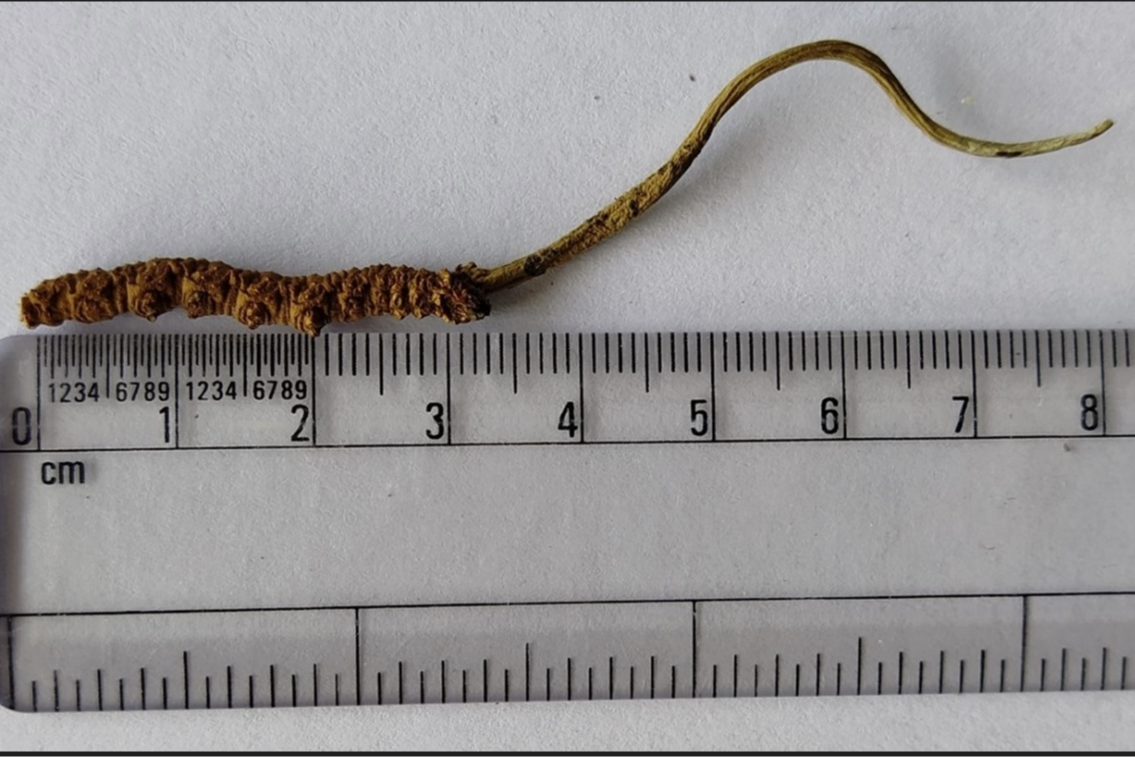New species of insect-parasitising fungus discovered in lower Himalayas

Researchers have discovered a new species of a fungus, Ophiocordyceps, in the lower Indian Himalayas. These fungi - fictionalised as the deadly fungi in The Last of Us - are well known as parasites of insects and are often prized for their medicinal qualities.
The research team, from the Council of Scientific and Industrial Research- Institute of Himalayan Bioresource Technology (CSIR-IHBT), Palampur, India, identified a previously unknown species of Ophiocordyceps and named it Ophiocordyceps indica sp. nov., a species new to science.
The new species, O. indica, was found infecting lepidopteran larvae from low height areas (2,202–2,653 m AMSL) of the Kullu District, Himachal Pradesh, in the Indian Western Himalayan region.
“Our group was searching for the presence of endangered O. sinensis or its alternative from new locations in the Indian Himalayas. During the course of surveys, we have identified a new species that can be an alternative to the highly prized and demanded O. sinensis that is supported by its morphological, chemical, genetic and biological activity data,” says corresponding author, Gireesh Nadda.
Study revealed that it has a ~59 Mb genome size showing 94% genetic similarity with yarsagumba, O. sinensis; however, it differs from other extant Ophiocordyceps species based on morphological characteristics, molecular phylogenetic relationships, and genetic distance, added Vishal Acharya.
Chemical profile
The recently identified fungus species, O. indica, exhibits a chemical profile that closely resembles to that of O. sinensis. The presence of targeted marker compounds, viz. nucleosides, amino acids, mannitol, and biological activity data, suggests it to be a new potential source of nutraceutical importance.
Fungal communities
Dr Nadda said that the research group at CSIR-IHBT had a strong interest in studying the fungal communities associated with O. indica and had identified a wide diversity of fungal species.
According to the authors, “It is worth mentioning that O. indica has almost similar fungal communities as reported from ’Himalayan Viagra’, O. sinensis. Investigating these various interconnected fungal communities shows great potential for uncovering valuable nutraceuticals and therapeutic agents. The findings offer potential for additional exploration into the mechanisms behind the infection, occurrence, and development of O. indica, which can help to promote its cultivation and reduce reliance on natural resources.”
Furthermore, untangling of culturable fungal communities associated with O. indica and soil adhered to it resulted in the identification of 111 fungal isolates representing 17 families, with maximum fungal isolates (36.03%) within Cordycipitaceae. Interestingly, a total of 24 genera were found associated with O. indica and adhered soil, of which 12 were common, 8 were exclusive to O. indica and 4 were only limited to soil.
Fungal communities associated with O. indica show their great potential for uncovering valuable nutraceuticals and therapeutic agents.
“The findings provide insights into the culturable fungal diversity of O. indica and the soil adhering to it, thus can contribute to the understanding of host‐microbial interactions. Additionally, these associations can be explored as a source of bioactive metabolites to combat the unending industrial demands,” said Nadda and Aakriti Sharma (Lead author and Doctoral Student)
Significant knowledge and practical issues
Nadda says that every newly discovered species has the capacity to reveal significant knowledge about biodiversity, ecology, and underlying evolutionary mechanisms.
“Nevertheless, the importance of these discoveries goes beyond mere scientific interest; it directly tackles practical issues and adds to multiple facets of human existence and the natural world. The discovery of a new species comparable to the already established medicinal mushroom, O. sinensis, has the potential to be used in the nutraceutical and health sector,” he added.
Doctoral student and Applied Microbiology International member Aditya Singh Ranout said: “The unexpected finding of O. indica at low altitudes (2,202–2,653 m AMSL) of the Kullu District, Himachal Pradesh, Indian Western Himalayan region was remarkable as compared to already known alpine meadow distribution (3000-5500 m AMSL) of O. sinensis.
“Further, morphological, chemical, genetic and associated fungal similarity between O. indica and O. sinensis is of special interest as, after generating the necessary data, O. indica can be an alternative to the highly prized O. sinensis,” said Nadda.
Mysterious questions
Nadda said the identification of fungi associated with O. indica and adhered soil collected from approachable low‐height areas of the Himalayas, compared to alpine meadow distribution of O. sinensis is of the utmost importance and may be used as a model insect‐fungal complex for future studies to solve some of the mysterious questions about Ophiocordyceps. The study’s findings indicate need for long term monitoring and management plans for sustainable harvesting of this identified fungus.
“The utmost necessity is to determine whether the pharmaceutical properties of Ophiocordyceps are attributable due to it or to the associated fungi, or the combined action of both. Further studies must be planned to fill the gap for a better understanding of these interactions. The associated fungi need to be explored for their industrial potential.”
The discovery of O. indica will alleviate the pressure on endangered O. sinensis by reducing its exploitation, therefore promoting its conservation. O. indica is a new Himalayan bioresource and the findings, thus, providing new research avenues regarding this mysterious fungus and its associated fungi.
This work is conducted by Gireesh Nadda and his research team of CSIR-IHBT. Funding is provided by CSIR, India. Authors acknowledge Director, CSIR-IHBT; the Academy of Scientific and Innovative Research, Ghaziabad; Himachal Pradesh Forest Department; and one of the authors acknowledge the ICMR, India for the fellowship.
The findings are outlined in papers in Frontiers in Microbiology and Journal of Basic Microbiology.
